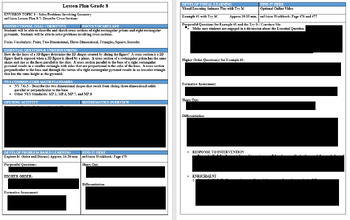7th Grade enVision Lesson Plan 8-7: Describe Cross Sections
- Word Document File
Description
This is an EXTREMELY DETAILED lesson plan that directly connects to the enVision Math Curriculum for 7th grade. This is one of nine lesson plans available for this unit. There is also a BUNDLE on my TPT store, were you can save money by purchasing all lesson plans together at once.
This is JUST THE LESSON PLAN DOCUMENT, NOT the actual activities or assessment tools.
This lesson plan is 4 pages long and includes the following categories:
- enVision Topic
- Next Generation / Common Core Standards
- Instructional Goals
- Essential Question
- Vocabulary
- Supplementary Materials
- Develop Problem Based Learning - Solve & Discuss It
- Practice and Application Activities
- Scaffolds / Differentiation / Questioning
- Developing Visual Learning with Examples and Videos
- Practice and Application
-Item Skills Analysis
- Special Education Component
- English Language Learner Component
- SEL Component
- Review, Assessment, and Extension
- Teacher Lesson Reflection Questions
This is JUST THE LESSON PLAN DOCUMENT, NOT the actual activities or assessment tools.
**PLEASE REMEMBER TO LEAVE A REVIEW :)
***TPT will give you "credits" for every review that you leave!!
****Thank you so much in advance!!




